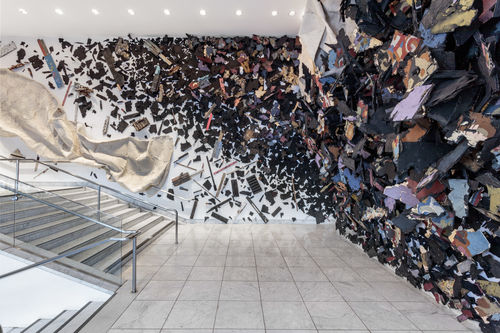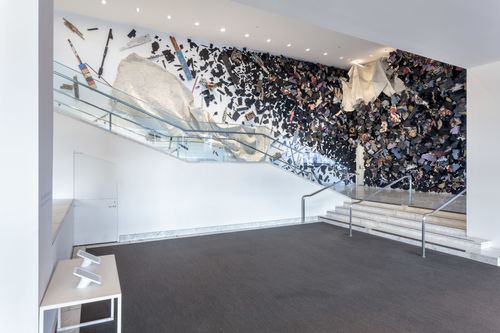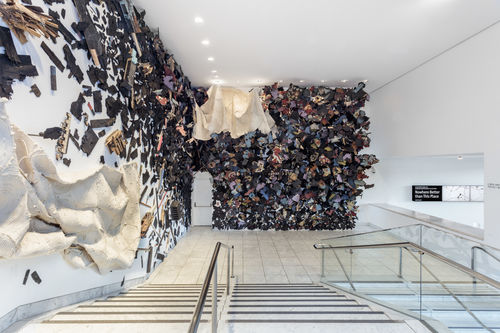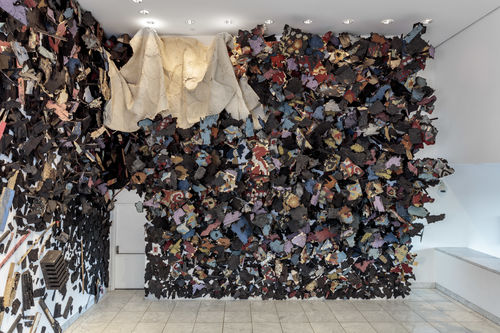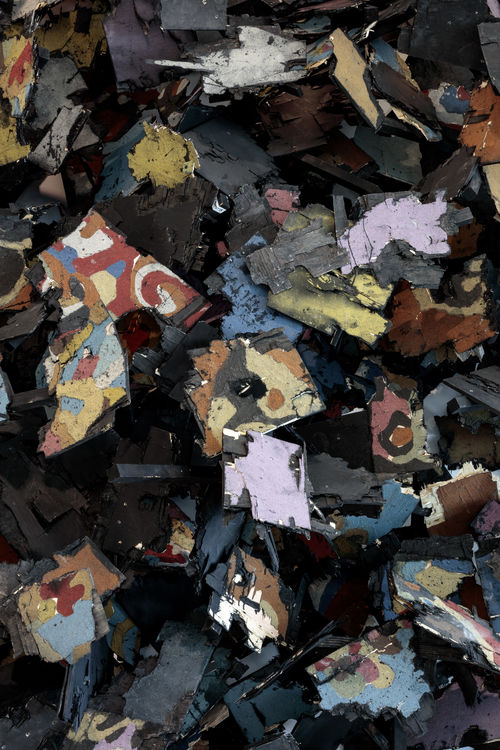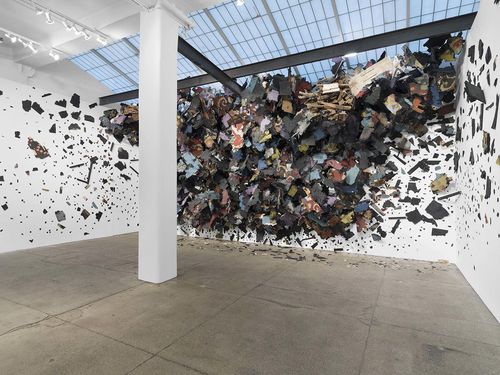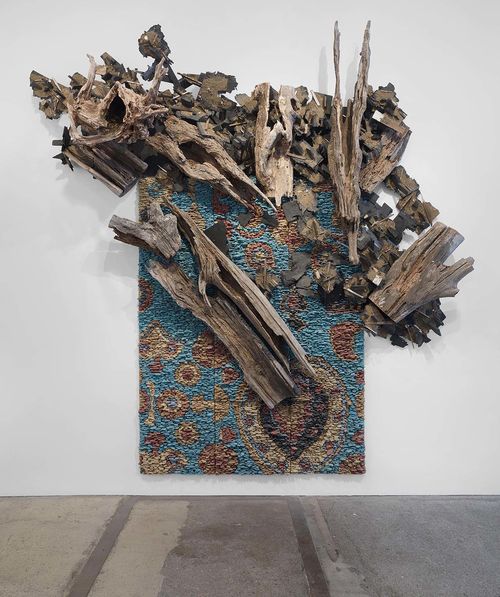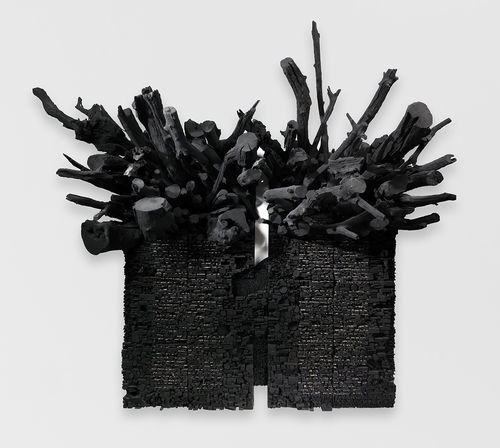
Hammer Projects: Leonardo Drew
- – This is a past exhibition
Leonardo Drew (b. 1961, Tallahassee, Florida) creates complex sculptural works that hover between order and chaos. Assembling and reworking large accumulations of raw material, Drew transforms his heavily referential materials—wood, scrap metal, cotton—into choreographed arrays of color and form. For the Hammer’s lobby wall, Drew reworks a recent piece made from roofing material, wood, and sandpaper. Evocative of the cycle of decay and erosion characteristic of any densely urban environment, the monumental arrangement of material draws a physical connection with the viewer as it invades and recedes in and out of our field of vision.
Hammer Projects: Leonardo Drew is organized by Connie Butler, chief curator.
Essay
By Connie Butler
Leonardo Drew has been making extraordinary sculptures and assemblage-based installations since the early 1990s. Always an accumulator of materials and materiality, Drew has said “I am the weather,” when speaking of the force and transformative exertion of process he harnesses to make his work. Indeed, to watch him work is to witness a firestorm combination of intuited gesture and willed control over space and the allocation and distribution of materials within it. What seems immediate and site responsive, in execution, requires careful planning and calculation. Sculptures and monumental installations that can appear chaotic or based on the logic of the found object are, in fact, highly orchestrated and carefully manipulated masses of sourced material. Drew selects, gathers and purchases wood and other construction materials and then paints and alters them to appear as though they have accrued a lifetime of wear and memory. Often allowing his heaps of wood and metal to germinate for a long time, he employs various techniques to distress and regenerate his materials until they look worn and lived in.
Born in Tallahassee, Florida and raised in Bridgeport, Connecticut, it is a familiar part of Drew’s narrative that he lived, with his single mother and four siblings, across the street from the town dump and was drawn to the entropic mass and materials he encountered there. The grids in his work that are often attributed to Minimalism, for example, Drew sees as references to the grid of the housing projects with which he is so familiar. As a child, he showed an unusual facility for traditional drawing and illustration techniques and was encouraged to pursue a life of creativity. Importantly Drew made the decision early to set aside these gifts in order to find a language of art that was more complex and could potentially contain meaning. Drew rigorously transformed his formally organized minimalist stacks and grids into imposing works that can hold social and cultural content, specifically of the African American and Black diasporic experience.1
Drew’s colleagues include artists such as the abstract painters Mark Bradford or Rodney McMillian each of whose engagement with abstraction has expanded the limits of what an identity based practice might look like. While using video and performance to pointedly expand the range of content and political critique that they tackle, both Bradford and McMillian repurpose found and used materials as the foundation of an abstraction that speaks to African American identity through embedded cultural signifiers that exist in the detritus of the urban environment. Drew and Bradford understand the importance of establishing a studio practice that mentors and supports men and women of color in the context of art practice. As two artists who were encouraged by their own extended family communities, each has created a studio environment which models a sustainable life in art making.
One of the most vivid of Drew’s personal narratives entails being given the use of a studio by the artist Jack Whitten. An artist of the 1960s generation who died in 2018, Whitten was a pioneer among black artists, an abstract painter in a largely white art world of lower Manhattan in the 1970s and 80s. Whitten was Drew’s teacher at Cooper Union from 1981 to 1985 and deeply impacted the young artist’s understanding of his materials and process. Previously somewhat unaware of the culturally coded implications of his material choices, Drew describes pushing a large bail of cotton thirty blocks, down the avenues of Manhattan to Whitten’s studio. He used the cotton to make monochromatic sculptures for a 1992 exhibition at Thread Waxing Space about abstraction and identity. The black and white images are striking: a young black man pushing cotton through traffic amongst the canyons of New York’s buildings and skyscrapers. Cotton would find form in large, wall scaled grids of stacked material. Drew realized the implication of identity and histories of slave labor might be read into such work. Whitten also knew this, about the inevitable profiling and narrow constraints of being an artist and a black man and he himself explored other avenues, including an entire body of African inspired assemblage sculpture he created while working in his summer home on the island of Crete. Even as his floor scrapings and rubbings yielded gorgeous, experimental abstract paintings and drawings, as early as 1968, Whitten found an outlet for another kind of content in his totemic, wooden figures. Drew synthesized each of these poles in his work. Understanding and mining his material and exploiting its potential, he is also extremely restrained and never indulges in the static experience or meaning of any one response.
One of Drew’s signature moves was the use of blackened wood which appeared to be charred and burned. The art historian Tyler Green has described the artist’s altered materials as “nudged towards collapse.”2 The dark, velvety black of the wood was actually achieved with paint. As is often the case Drew uses paint to distress and age his sculptures knowingly and masterfully exploiting the symbolic potential of the material’s blackness. The imposing wall structures he constructs take on the scale of architecture and Drew talks about creating enough room so that the viewer can find themselves in his work. The installation at the Hammer is one of an ongoing series of numbered installations that are magnificent, engulfing explosions of form. Based on a project for Galerie Lelong in New York in the summer of 2019, Number 215A is a more expansive and unruly version of this work. Made in a remarkably short time, the Hammer lobby wall installation was the result of one gesture. Like a musical phrase or composition—the artist often speaks of the rhythms and structure of jazz—the spray of material filled the wall in a single, planned expulsion. Materials are bought and culled, painted and altered to look used and recently Drew has been incorporating color into his previously monochromatic works. The color looks aged, like the bleached generic colors of roofing materials that might be found in the working-class neighborhood of the artist’s Brooklyn studio. The array has the speculative informality of drawing, like remnants reanimated from a previous context. The large, white carpet is from an ongoing series of spiral textile forms that exist as spontaneous experiments between bodies of work. This particular fragment was worked on when the artist was in Peru in the fall of 2019 planning his installation at the Hammer. For all of its rigor, there is great joy and indulgence in these spiraling waves of fabric that Drew choreographs to form a material punctum and focal point within his material expanse.
There is an image in one of the videos that documents Drew’s studio process in which he stands amidst heaps of wood gathered in his studio. Working on approximately seven works at a time, the artist moves between each composition adding a gesture here or inserting a dowel there. He moves between his carefully gathered piles as if conducting an orchestra-with one eye on each micro gesture and line of a given work, he also allows the pieces to inform one another. At one moment he climbs a ladder and, perched atop to get a bird’s eye view, he surveys the landscape in his studio. Zooming in and out, collapsing views and time, he silently but with great care and precision, alters and reanimates the landscape of material before him.
Notes
1. See https://www.nytimes.com/2019/05/30/arts/design/leonardo-drew-madison-square-park.html.
2. Tyler Green, Modern Art Notes, https://manpodcast.com/portfolio/no-401-leonardo-drew/.



